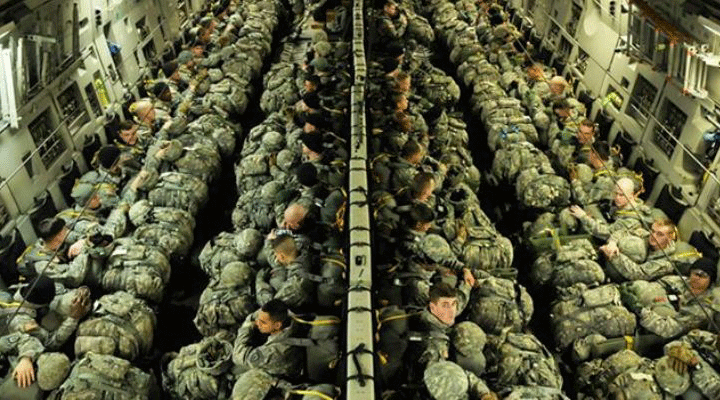The recent arrest of Coast Guard Lt. Christopher Hasson on drug, weapons, and conspiracy charges, and the unrelated uncovering of a young Marine’s embarrassingly pro-Nazi Twitter posts, has left the nation’s armed services on the defensive domestically, facing renewed charges of white supremacy in the ranks.
Regardless of whether the number of white supremacists (or other extremists) in the ranks is large or small, the problem is real. The military brass must find an effective way of dealing with it. Because the presence of overt racists in the ranks is as damaging to readiness as any training or maintenance issue.
The would-be terrorist in Coast Guard Headquarters
The FBI quietly arrested Hasson on February 15, and filed a motion for detention pending trial in the Maryland U.S. District Court on February 19. The details would be shocking in any case, but are especially troubling for a commissioned officer in the armed services. Hasson, who served in the Marine Corps and Army National Guard between 1988 and 1993, is an acquisition officer in the National Security Cutter program at Coast Guard Headquarters.
The government’s motion was blunt, beginning, “The defendant intends to murder innocent civilians on a scale rarely seen in this country.” The charge continues, “The defendant is a domestic terrorist, bent on committing acts dangerous to human life that are intended to affect governmental conduct.”
Being a Neo-Nazi isn’t illegal by itself, nor is owning the firearms and ammunition Hasson had stored in his house in Silver Spring, MD, just outside Washington, D.C. The initial charges against Hasson actually stem from his possession of Tramadol, a synthetic opiate. Since his journal entries make it clear he had been using the drug, he was also charged with “possession of a firearm and ammunition by an unlawful user or addict of controlled substances.” More charges will surely follow, as the government called the initial charges “the tip of the proverbial iceberg.”
The document paints a chilling picture of a deeply disturbed individual, a condition do doubt exacerbated by his opioid use.
The Neo-Nazi Lava Dog
In Hawaii, another white supremacist, a Marine assigned to 1st Battalion, 3rd Marines, the “Lava Dogs,” has deleted his Twitter account after other veterans drew attention to it. Here’s a pro tip: if you’re an active member of the armed forces of the United States, refrain from tweeting photos where you’ve arranged blocks of TNT into a swastika, or where you say you look at the photo of priests giving the Nazi salute before going to bed each night, or a photo showing a white Marine, his face blackened with camouflage paint, captioned “hello, fellow black men.”
Several people contacted the Marine’s chain of command privately and allegedly received assurances that they will deal with the situation appropriately. With the caveat that I’m not a lawyer, it would seem the young man’s incendiary tweets could lead him to face a charge of “provoking speeches or gestures” under Article 117 of the Uniform Code of Military Justice.
Taken alone, each of these incidents is ugly enough. But more widely, they raise the very serious question of how widespread the threat of extremism in the military actually is.
A Decades-old fight
The military began to address the issue seriously more than 20 years ago. Two specific incidents in 1995 led to this revival: former soldier Timothy McVeigh’s April bombing of the Murrah Federal Building in Oklahoma City, and the December racially motivated murder of two black men in Fayetteville, N.C. by two white privates assigned to the the Army’s 82nd Airborne Division.
I recall vividly a 1997 pre-deployment briefing on extremism, and the years of mandatory briefings that followed. But those briefings themselves received unwanted attention when, in April 2013, a U.S. Army Reserve briefing surfaced that listed “Evangelical Christians” and “Catholics” as examples of extremist groups. That October, another briefing given at Camp Shelby in Arkansas labeled the American Family Association, a large evangelical Christian ministry, as a hate group.
The fight against extremism had itself somehow itself become extreme. Following the October revelation, an Army spokesman told Fox News that Secretary of the Army John McHugh had “directed that Army leaders cease all briefings, command presentations or training on the subject of extremist organizations or activities until that program of instruction and training has been created and disseminated.” I’m not aware that those briefings ever resumed. What I do know is that the Department of the Army pamphlet on extremism, DA PAM 600-15, is no longer listed among the Army’s active DA pamphlets.
The problem persists
A 2017 Military Times annual survey of active duty service members revealed that one-in-four respondents reported having “seen examples of white nationalism among their fellow service members.” This is, to say the least, disappointing. The presence of overt racism in the ranks is unquestionably bad for unit discipline. Every soldier, sailor, airman, Marine, and coast guardsman must be able to rely on the men and women to the left and right for survival. Even a shred of doubt about whether or not the other guy will be there when you need him (or her) can be fatal.
But neither can the effort be, to borrow a phrase in the news a lot lately, a “witch hunt.” Seeing extremists in every shadow, whether they’re there or not, is also detrimental to unit cohesiveness. Hyper-vigilance is as bad as indifference. I don’t claim to know the right balance between protecting the right of individuals to believe what they want (however abhorrent), and the right of every service member—of every race and creed—to be free of the fear that their brothers- and sisters-in-arms harbor a deep-seated hatred for them.
I do know that finding the solution to this problem is vital to the future health of the force.




